Hemodynamic phenomenon - Study guides, Class notes & Summaries
Looking for the best study guides, study notes and summaries about Hemodynamic phenomenon? On this page you'll find 246 study documents about Hemodynamic phenomenon.
Page 2 out of 246 results
Sort by
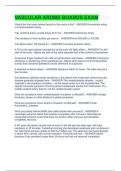
-
VASCULAR ARDMS BOARDS EXAM
- Exam (elaborations) • 47 pages • 2023
- Available in package deal
-
- $13.99
- + learn more
What's the first major arterial branch of the aorta is the? - ANSWER-Innominate artery or brachiocephalic artery The vertebral artery usually arises from the: - ANSWER-Subclavian Artery The incidence of new strokes per year is: - ANSWER-from 500,000 to 700,000 The abbreviation TIA stands for: - ANSWER-Transient Ischemic Attack A TIA of the right anterior hemisphere of the brain will likely affect: - ANSWER-The left side of the body - affects the side of the body opposite that of the...
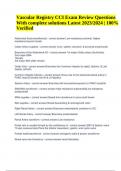
-
Vascular Registry CCI Exam Review Questions With complete solutions Latest 2023/2024 | 100% Verified
- Exam (elaborations) • 65 pages • 2023
-
- $18.49
- + learn more
Vascular Registry CCI Exam Review Questions With complete solutions Latest 2023/2024 | 100% Verified. Abdominal Aorta waveform(s) - correct answer Low resistance proximal, Higher resistance beyond renals Celiac Artery supplies - correct answer Liver, spleen, stomach, & proximal small bowel Branches of the Abdominal AO - correct answer 1st major-Celiac artery (trunk/axis) 2nd major-SMA Renals 3rd major-IMA (after renals) Celiac Axis - correct answer Branches into Common Hepatic (to right),...
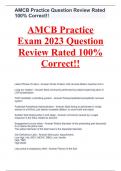
-
AMCB Practice Exam 2023 Question Review Rated 100% Correct!!
- Exam (elaborations) • 40 pages • 2023
- Available in package deal
-
- $14.99
- + learn more
AMCB Practice Exam 2023 Question Review Rated 100% Correct!! Latent Phase of Labor - Answer Onset of labor until cervical dilation reaches 4-6 m Long arc rotation - Answer Most commonly performed by babies beginning labor in LOP presentation FHR Variability: controlling system - Answer Parasympathetic/sympathetic nervous system Pudendal Anesthesia Administration - Answer Ideal timing to administer in multip women is at 8-9cm, just before complete dilation, to cover birth and repair Sudden fetal...
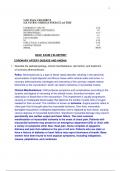
-
N4581 EXAM 2 BLUEPRINT
- Exam (elaborations) • 108 pages • 2024
-
- $14.99
- + learn more
1 N4581 EXAM 2 BLUEPRINT CORONARY ARTERY DISEASE AND ANGINA 1. Describe the pathophysiology, clinical manifestations, risk factors, and treatment of coronary atherosclerosis. Patho: Atherosclerosis is a type of blood vessel disorder resulting in the abnormal accumulation of lipid deposits and fibrous tissue within arterial walls and lumen. In coronary atherosclerosis, blockages and narrowing of the coronary vessels reduce blood flow to the m...
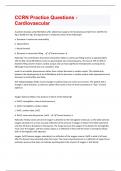
-
CCRN Practice Questions - Cardiovascular Questions and Answers well Explained Latest 2024/2025 Update 100% Correct.
- Exam (elaborations) • 22 pages • 2024
- Available in package deal
-
- $7.99
- + learn more
A patient develops atrial fibrillation after abdominal surgery. Her blood pressure falls from 110/70 mm Hg to 92/68 mm Hg. The hypotension is related to which of the following? a. Decrease in ventricular contractility b. Hypovolemia c. Mural thrombi d. Decrease in ventricular filling - Correct answer: d Rationale: The contribution that atrial contraction makes to ventricular filling volume is approximately 15% to 30%. Atrial fibrillation results in quivering but not contracting atria. The...

-
CCRN PEDS Cardiovascular 2022 Questions and Answers With rationale
- Exam (elaborations) • 19 pages • 2024
-
- $13.49
- + learn more
CCRN PEDS Cardiovascular 2022 Questions and Answers With rationale 1. Your pediatric patient has the following parameters HR 80 BP 100/60 SV 40 BSA 0.9 m2 The cardiac index (CI) for this patient is A. 4.4 L/min B. 3.2 L/min/m2 C. 3.5 L/min/m2 D. 3200 mL/m2 C. The cardiac index for this patient is 3.5. First, you must calculate the cardiac output (HR X SV) or (80 X 40 =3200 = 3.2 L/min). Then, use the following equation: (CI = CO/BSA) or (3.2/0.9 = 3.55 L/min/m2) The CI is a ...
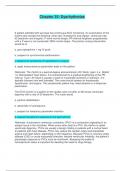
-
Chapter 35: Dysrhythmias | Questions, Answers and Rationales
- Exam (elaborations) • 73 pages • 2024
-
- $28.49
- + learn more
Chapter 35: Dysrhythmias | Questions, Answers and Rationales A patient admitted with syncope has continuous ECG monitoring. An examination of the rhythm strip reveals the following: atrial rate 74 beats/min and regular; ventricular rate 62 beats/min and irregular; P wave normal shape; PR interval lengthens progressively until a P wave is not conducted; QRS normal shape. The priority nursing intervention would be to a. give epinephrine 1 mg IV push. b. prepare for synchronized cardioversion. c...

-
AMCB Practice Test Questions with Correct Answers
- Exam (elaborations) • 41 pages • 2024
-
Available in package deal
-
- $13.99
- + learn more
AMCB Practice Test Questions with Correct Answers Latent Phase of Labor - Answer-Onset of labor until cervical dilation reaches 4-6 m Long arc rotation - Answer-Most commonly performed by babies beginning labor in LOP presentation FHR Variability: controlling system - Answer-Parasympathetic/sympathetic nervous system Pudendal Anesthesia Administration - Answer-Ideal timing to administer in multip women is at 8-9cm, just before complete dilation, to cover birth and repair Sudden fetal...

-
Vascular Davies Questions And Answers
- Exam (elaborations) • 14 pages • 2023
-
Available in package deal
-
- $12.49
- + learn more
Amaurosis Fugax can be interpreted as a: - Answer- Transient ischemic attack True regarding subclavian steal? - Answer- It is usually a harmless hemodynamic phenomenon and it is caused by arterial obstruction proximal to the origin of the vertebral artery. Bruits heard bilaterally, loudest low in the neck, are most likely caused by: - Answer- Aortic valve stenosis During ordinary auscultation of a carotid bifurcation, the detection of a bruit that extends into diastole is: - Answer- Hig...
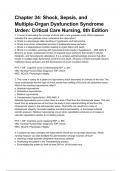
-
Chapter 34: Shock, Sepsis, and Multiple-Organ Dysfunction Syndrome Urden: Critical Care Nursing, 8th Edition Complete Questions and Answers A+
- Exam (elaborations) • 12 pages • 2024
-
- $13.48
- + learn more
Chapter 34: Shock, Sepsis, and Multiple-Organ Dysfunction Syndrome Urden: Critical Care Nursing, 8th Edition Complete Questions and Answers A+ 1. A nurse is discussing the concept of shock with a new graduate nurse. Which statement indicates the new graduate nurse understood the information? a. Shock is a physiologic state resulting in hypotension and tachycardia. b. Shock is an acute, widespread process of inadequate tissue perfusion. c. Shock is a degenerative condition leading to organ fa...

Did you know that on average a seller on Stuvia earns $82 per month selling study resources? Hmm, hint, hint. Discover all about earning on Stuvia


